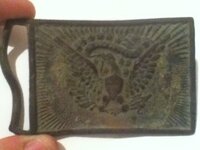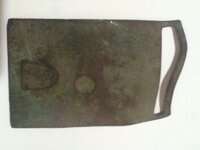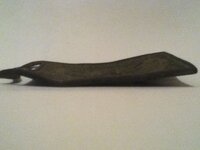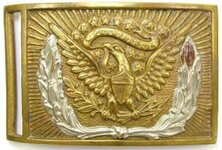This find is definitely out of my realm, living in Kansas and all. I found it on about 2 inches deep at the former site of a home in town. I've searched online and have found many similar but not the exact same. I believe the numbers on the back to be 192
Navigation
Install the app
How to install the app on iOS
Follow along with the video below to see how to install our site as a web app on your home screen.
Note: This feature may not be available in some browsers.
More options
You are using an out of date browser. It may not display this or other websites correctly.
You should upgrade or use an alternative browser.
You should upgrade or use an alternative browser.
✅ SOLVED Belt plate id help needed
- Thread starter stikman
- Start date
TheCannonballGuy
Gold Member
- Feb 24, 2006
- 6,590
- 13,346
- Detector(s) used
- White's 6000, Nautilus DMC-1, Minelab
- Primary Interest:
- Relic Hunting
Stikman wrote:
> I marked this as solved because I have no idea what I'm doing.
No need to try to undo the mistake, because here is your find's very-exact ID.
It is indeed a belt buckle... specifically, a US Army sword-belt buckle, Regulation 1851 Pattern. Your specimen, like most excavated ones, is missing the stamped nickel-silver wreath which was applied to the buckle's front just below (and partially surrounding) the spread-winged eagle.
Although your buckle's wreath is missing, your photo shows there's no provision for the wreath to extend across the eagle's wingtips. Therefore, your buckle dates from sometime between 1861 and 1873. (In 1874 the buckle's design was changed and thus was known as the 1874 Pattern.
The buckle's width was enlarged in 1864, so we need to know your find's very-precise width measurement to know whether it dates from 1861-63 or 1864-73.
Your buckle shows no sign of gold-gilting, so it was made for Enlisted-men's use. (The Officer's version was gold-gilted.)
The small shallow round dimple in your solid-cast brass buckle's back means it was also die-stamped to create "crisper" detail in the emblem on its front.
The small numbers on the back are the manufacturer's "benchmark" number. Similar numbers are occasionally seen on other examples of sword-belt buckles. Unfortunately, it is definitely not an army regiment number.
UPDATE: I did some additional research for you, to narrow down your sword-belt buckle's date range. On the great majority of these 1851-Pattern buckles, the emblem either has no "rays" at all, or the "rays" are only above the eagle. Note that on your specimen, the eagle is entirely surrounded by "rays." That version was only manufactured between December 1863 and 1865.
> I marked this as solved because I have no idea what I'm doing.
No need to try to undo the mistake, because here is your find's very-exact ID.
It is indeed a belt buckle... specifically, a US Army sword-belt buckle, Regulation 1851 Pattern. Your specimen, like most excavated ones, is missing the stamped nickel-silver wreath which was applied to the buckle's front just below (and partially surrounding) the spread-winged eagle.
Although your buckle's wreath is missing, your photo shows there's no provision for the wreath to extend across the eagle's wingtips. Therefore, your buckle dates from sometime between 1861 and 1873. (In 1874 the buckle's design was changed and thus was known as the 1874 Pattern.
The buckle's width was enlarged in 1864, so we need to know your find's very-precise width measurement to know whether it dates from 1861-63 or 1864-73.
Your buckle shows no sign of gold-gilting, so it was made for Enlisted-men's use. (The Officer's version was gold-gilted.)
The small shallow round dimple in your solid-cast brass buckle's back means it was also die-stamped to create "crisper" detail in the emblem on its front.
The small numbers on the back are the manufacturer's "benchmark" number. Similar numbers are occasionally seen on other examples of sword-belt buckles. Unfortunately, it is definitely not an army regiment number.
UPDATE: I did some additional research for you, to narrow down your sword-belt buckle's date range. On the great majority of these 1851-Pattern buckles, the emblem either has no "rays" at all, or the "rays" are only above the eagle. Note that on your specimen, the eagle is entirely surrounded by "rays." That version was only manufactured between December 1863 and 1865.
Attachments
Last edited:
Upvote
0
TheCannonballGuy
Gold Member
- Feb 24, 2006
- 6,590
- 13,346
- Detector(s) used
- White's 6000, Nautilus DMC-1, Minelab
- Primary Interest:
- Relic Hunting
You wondered about how your buckle got to where you dug it:
Because your "rays entirely surrounding the eagle" version is one of the few varieties of US Army 1851-Pattern sword-belt buckle that we can be 100% certain was manufactured ONLY during the civil war years, the most probable answer to your question is civil war military activity in Kansas. The yankee army stationed cavalry troops in that state throughout the entire war, due to Confederate cavalry guerilla raids.
Therefore, I urge you to hunt that lawn very thoroughly. (Of course, be very careul not to tear up the lawn, angering the howeowner, unless he is you.) The odds tend to favor your buckle being not the one-&-only civil war relic in that lawn, or in the nearby vicinity. Please give us a report after several more hunts.
Because your "rays entirely surrounding the eagle" version is one of the few varieties of US Army 1851-Pattern sword-belt buckle that we can be 100% certain was manufactured ONLY during the civil war years, the most probable answer to your question is civil war military activity in Kansas. The yankee army stationed cavalry troops in that state throughout the entire war, due to Confederate cavalry guerilla raids.
Therefore, I urge you to hunt that lawn very thoroughly. (Of course, be very careul not to tear up the lawn, angering the howeowner, unless he is you.) The odds tend to favor your buckle being not the one-&-only civil war relic in that lawn, or in the nearby vicinity. Please give us a report after several more hunts.
Upvote
0
Top Member Reactions
-
 3786
3786 -
 2103
2103 -
 1884
1884 -
 1465
1465 -
 1456
1456 -
 1072
1072 -
 905
905 -
 891
891 -
 845
845 -
 811
811 -
 691
691 -
 680
680 -
 637
637 -
 490
490 -
 466
466 -
 461
461 -
E
418
-
 414
414 -
 350
350 -
 341
341
Users who are viewing this thread
Total: 2 (members: 0, guests: 2)







